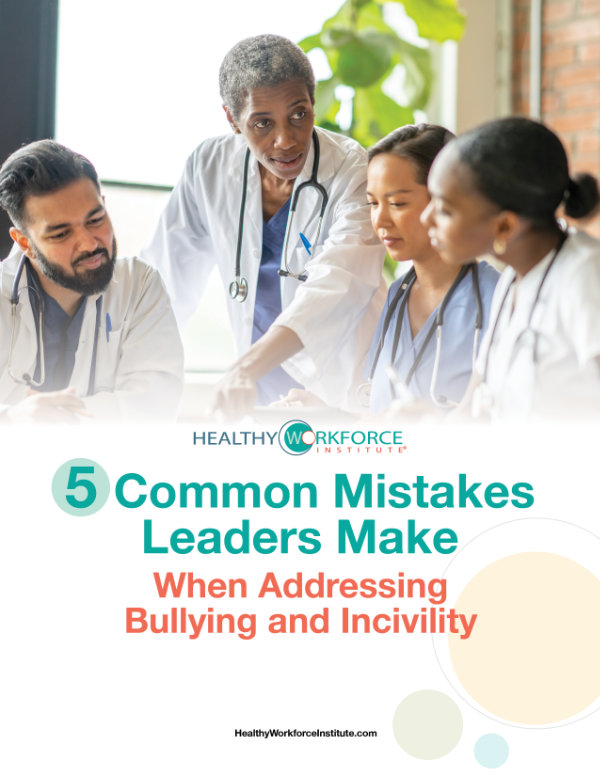I’m considered a healthcare workplace-bullying expert and over the years, I’ve learned an important aspect of bullying.
If an organization has a bullying problem – they have a leadership problem.
Sounds harsh, but it’s the truth.
With skilled leaders who know how to set behavioral expectations, hold their people accountable, model professional behavior, and engage, recognize, and influence staff, the result is a culture that rejects bullying and incivility and promotes professionalism.
Once I recognized this, I began to spend time developing leaders. It’s funny because there were times while working with an organization to eliminate workplace bullying and incivility; I identified a leadership issue and recommended a leadership coach (not me) for various individuals.
I’ve said NUMEROUS times – “I’m not a leadership coach.” I’m a workplace bullying expert and dabble in leadership development. However, coaching leaders is exactly what I find myself doing almost every day.
The leaders I work with frequently text me, email, or just randomly call me asking for advice. I love it because I’ve been able to advise them on how to handle the unique situations that pop up in the workplace on a daily basis.
WHAT NOT TO DO
One of the leaders I was working with hired a new assistant manager, Brian. She really wanted Brian to build a relationship with me as she had, so we scheduled time to talk after he got acclimated on the unit.
When Brian and I talked on the phone for the first time, my internal red flags were thrown like a football coach during a critical game. Brian told me that during his first few days shadowing the staff nurses, he deliberately kept his badge turned backwards so that nobody could see his name and title. He wanted to see how the staff behaved when management wasn’t around. It wasn’t until the end of his third day that he turned his badge around and everyone could see that indeed, he was actually the new assistant manager.
While talking with him, I got the sense that he was bragging at the fact that when the staff saw whom he really was, they were surprised and immediately acted differently. He “caught” them. He thought that tricking the staff so that he could know what was happening when they thought nobody was watching was great, smart way to begin his role as their leader.
Where the heck did he learn leadership skills??? Ugh.
Needless to say, Brian did not bond with the staff and was eventually let go but not after leaving a trail of casualties on the unit.
ADVICE FOR NEW LEADERS
I get asked for advice frequently from new leaders who are not sure how to begin their leadership role.
Should they come across as warm and friendly or will that prevent them from holding their people accountable down the line?
Should they come across as competent and strong or will that make staff afraid and less likely to engage?
The answer is both.
Employees need to feel that they can trust their leader; that their leader is competent yet approachable and fair. But it’s the order in which you approach your new team that is the most important.
[Tweet “If an organization has a bullying problem – they have a leadership problem. Nurse Leaders: Connect, Then Lead”]
An article published by the Harvard Business Review titled, “Connect, Then Lead”, shares the growing body of evidence that answers the question, “Is it better to be loved or feared?” Is it better for new leaders to show their strength and competence initially to gain credibility with their staff or warmth and friendliness to build relationships first?
The overwhelming research shows that warmth trumps strength any day.
Why? Because it’s the relationships that matter most.
New leaders build relationships by establishing trust; by displaying warmth, kindness, and care.
Once relationships are built, then the leader can gradually demonstrate their competence and strength. Unfortunately, many new leaders tend to emphasize their strength and credentials, which is the wrong approach. Tricking your staff by pretending to be someone you’re not just so that you can see what they’re really like, is soooooo wrong! If I were Brian’s boss, I would have fired him on the spot!
Remember, it’s the leadership that determines the culture in an organization.
Your people EXPECT that their leaders are competent, strong, and will advocate for them.
But what they WANT from their leaders is their warmth, compassion, and to trust them.
Thanks so much for reading. Take care and stay connected!


If you like this post, I recommend the following:
Share with your colleagues and friends using the social share buttons.
Subscribe to my blog. Sign up to receive my latest updates and other resources via my website.
Dr. Renee Thompson works with healthcare organizations that want to overcome the leadership and clinical challenges their people face every day.
If you’d like to find out more about her programs, please visit her website www.reneethompsonspeaks.com.
Contact Renee today at [email protected] to bring her to your organization to talk about ending the cycle of nurse bullying.













1 thought on “Want To Prevent A Bullying Culture? Connect First, Then Lead”
5